20.3 Pedigree Analysis
What is a pedigree?
A pedigree chart is a diagram that models the inheritance of phenotypes from one generation to the next. Pedigree charts are used by scientists, genetic counselors, and animal breeders. Pedigrees show inheritance across one or more generations. Individuals connected by a horizontal line have mated and had children. Vertical lines connect parents to their children. Siblings are generally shown from left to right according to birth order.

In a pedigree chart, females are symbolized by a circle and males are symbolized by a square. Sometimes the gender of an individual is not identified in the pedigree; these individuals are symbolized by a diamond. A gender may not be specified in the pedigree for one of several reasons: the person’s gender may be unknown, the person may not identify as male or female, the person may be intersex, or the person’s gender may be withheld for privacy reasons. Sometimes diamonds are used for all individuals in a pedigree, when it is not clinically relevant to specify their gender.
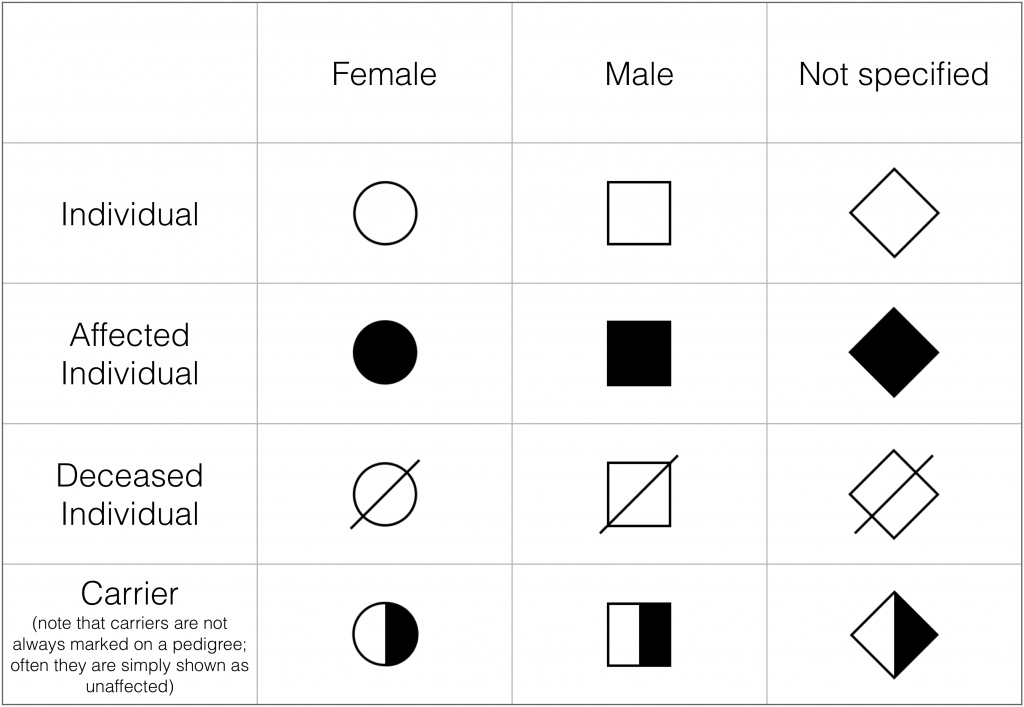
Shading represents that the individual is affected by the disease or condition. Pedigree charts do not always include shaded shapes, because sometimes a pedigree is constructed for a reason other than following a disease or condition. Sometimes heterozygotes are indicated by shading half of the shape, but often they are not indicated and are simply shown as unaffected.
Pedigrees can be used to study the genetics of inherited diseases. They can be analyzed to determine whether a genetic condition is autosomal or sex-linked, and whether it is dominant or recessive. We can also ask questions about the genotype of individuals on a pedigree given their phenotypes.
Pedigree Analysis
Pedigree charts display different patterns depending on which inheritance mechanism is responsible for the trait. Scientists can analyze pedigree charts to study how inherited disorders are transmitted. The most common modes of inheritance are autosomal recessive, autosomal dominant, X-linked recessive, and X-linked dominant. There are also a handful of Y-linked and mitochondrial disorders.
Autosomal Recessive Inheritance
Some genetic conditions are autosomal recessive, meaning that the gene involved is found on an autosome, and affected individuals have two copies of the allele that causes the condition. If an affected individual in a pedigree has two unaffected parents, the condition is most likely recessive. Additionally, if daughters in the pedigree have two unaffected parents, the condition is most likely autosomal recessive (unlike X-linked recessive conditions, in which an affected daughter will have an affected father). With autosomal recessive inheritance, males and females are equally likely to be affected.
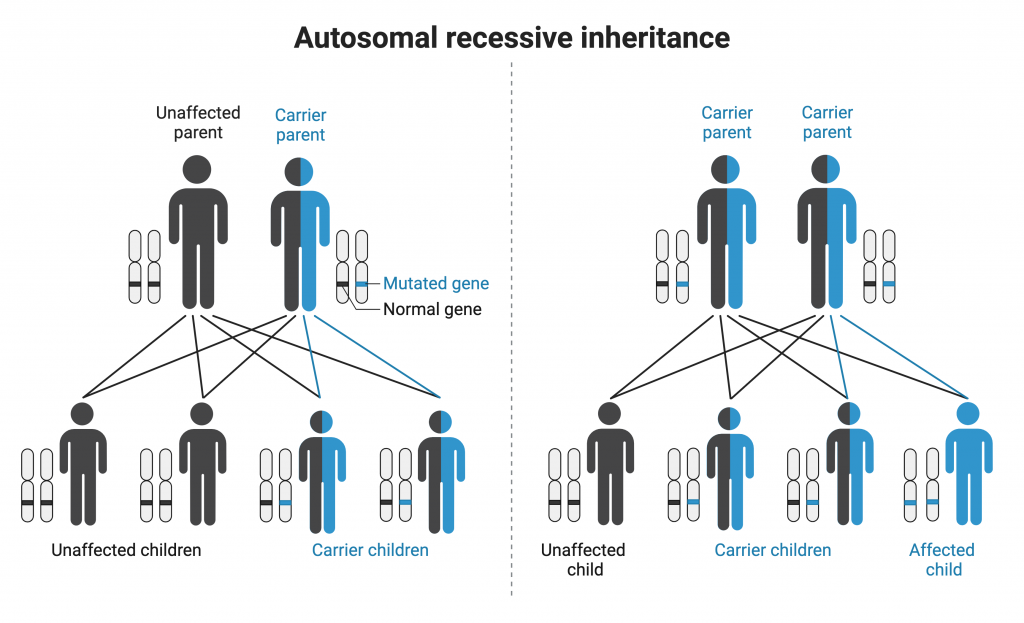
Autosomal recessive conditions in humans include cystic fibrosis, sickle cell disease, Tay-Sachs disease, and phenylketonuria.

It is helpful to be able to assign genotypes to all individuals on a pedigree chart in order to predict if it is possible that an individual might pass along a mutant allele to their offspring. When the inheritance mechanism is autosomal recessive, it is helpful to start with affected individuals. All affected individuals are expected to be homozygous recessive in genotype (for example, genotype aa). Looking at individual 7 on the pedigree chart above, we would then recognize that both parents (individuals 1 and 2) must carry a copy of the mutant allele. Both parents are expected to be heterozygous in genotype because neither one is affected by the trait. One can then determine the genotypes of the siblings of individual 7. Here, we do not know whether individuals 5 and 6 are heterozygous or homozygous for the normal allele because no offspring are shown. However, we can conclude that individual 4 is heterozygous for the relevant gene because her daughter (individual 10) expresses the trait. Furthermore, one can conclude that both individual 3 and individual 11 must also be heterozygous for the relevant gene.
Autosomal Dominant Inheritance
Genetic conditions can display autosomal dominance. In this mode of transmission, a single mutant allele is sufficient to cause the condition because the mutant allele is dominant over the normal allele. Affected children generally have at least one affected parent (although not always, because some conditions display incomplete penetrance, meaning that not every individual with the allele will display the phenotype). Males and females are equally affected.
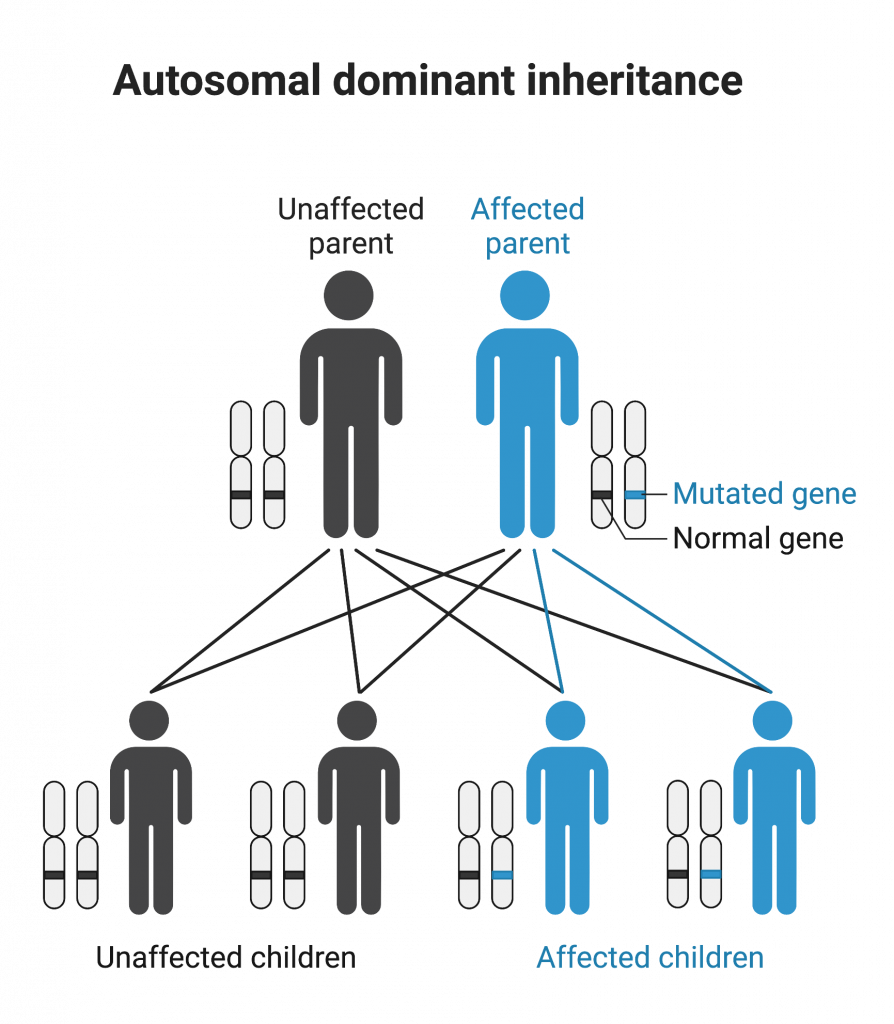
Autosomal dominant conditions in humans include Marfan syndrome, Huntington’s disease, and achondroplasia.

Let’s think about assigning genotypes to individuals on a pedigree chart representing an autosomal dominant trait. Each affected individual must have one or two copies of the mutant allele; each unaffected individual is expected to be homozygous for the normal allele (genotype aa). One of the 4 children of parents 1 and 2 is not affected by the trait and hence must have two copies of the normal allele which acts in a recessive fashion (genotype aa). This would suggest that individual 1 is heterozygous in genotype (Aa). Furthermore, individuals 6, 8, and 9 are also expected to be heterozygous because their father is homozygous recessive in genotype.
X-linked Recessive Inheritance
Some conditions are sex-linked, meaning the gene that causes the condition is on one of the sex chromosomes. In mammals, this is usually the X chromosome, because the X chromosome is much larger and has many more genes. X-linked recessive conditions are much more common in males, because they have only one X chromosome. Therefore, if they inherit an X chromosome with the mutated allele that causes the condition, they will display the condition. Females must inherit two copies to display an X-linked recessive condition. Males cannot be carriers; they will either be affected or unaffected, depending on which allele they inherit on the X chromosome.
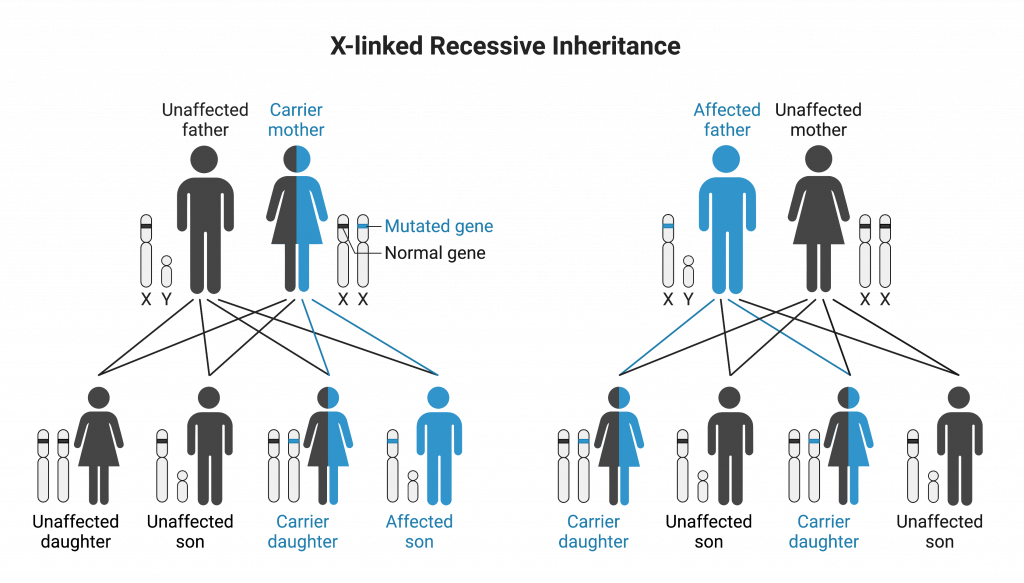
In pedigrees that display X-linked recessive inheritance, sons of a carrier mother and an unaffected father have a 50% chance of being affected, while daughters will not be affected, but have a 50% chance of being carriers (heterozygotes). Sons of an affected mother will all be affected. There is no father-to-son transmission of X-linked traits.

Examples of X-linked recessive conditions include Duchenne muscular dystrophy, the most common form of color blindness, and hemophilia A and B.
To assign genotypes to individuals on a pedigree chart representing an X-linked recessive trait, it is important to recognize two things: 1. Males only have one copy of the X chromosome and females have two copies, and 2) the presence of one normal allele will result in an unaffected individual. Thus all unaffected males will have a copy of the normal allele (genotype XAY, and all affected males will have a copy of the mutant allele (genotype XaY). All three of the affected males are expected to have the XaY genotype, having received the X chromosome from their mother. Thus individuals 1 and 7 are both heterozygous females with genotype XAXa.
X-linked Dominant Inheritance
Conditions that display X-linked dominant inheritance are less common than X-linked recessive conditions. For this mode of inheritance, affected fathers will pass on the allele and condition to all of their daughters. Sons of an affected, heterozygous mother have a 50% chance of being affected.
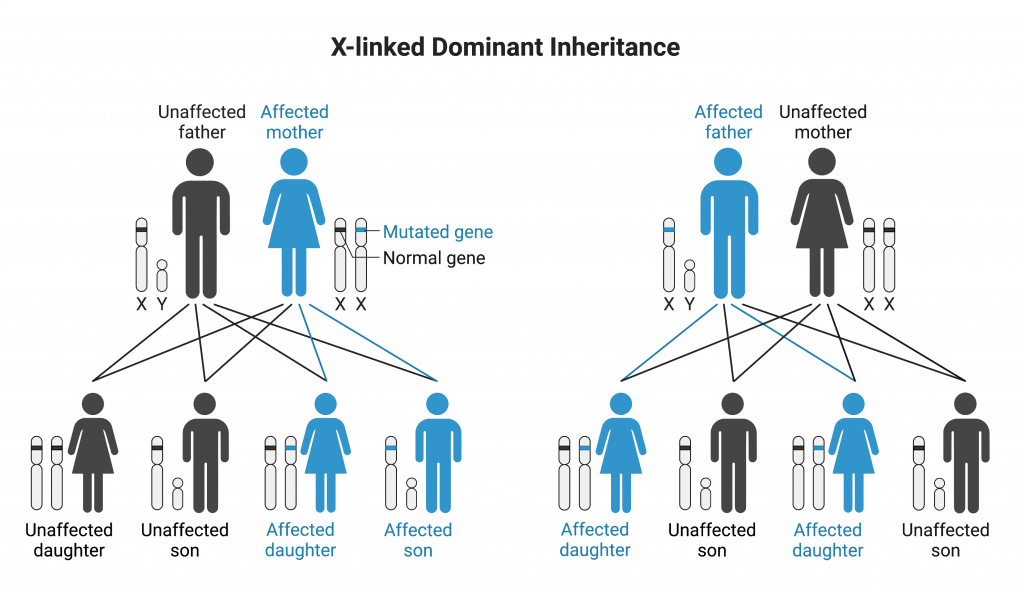
Examples of X-linked dominant inheritance include Rett syndrome and most cases of Alport syndrome.

In order for a daughter to be homozygous for the mutant allele, both of her parents must be affected by the mutant trait. Thus all affected females on this chart are heterozygous in genotype.
trait or condition that is transmitted on one of the autosomes (chromosomes that are not sex chromosomes)
trait or condition transmitted on one of the sex chromosomes (in mammals, usually the X chromosome)
trait which confers the same physical appearance whether an individual has two copies of the trait or one copy of the dominant trait and one copy of the recessive trait
trait that appears “latent” or non-expressed when the individual also carries a dominant trait for that same characteristic; when present as two identical copies, the recessive trait is expressed

